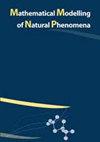部分被固体膜覆盖的浅腔中径向对称热毛细流的结构变化
IF 2.1
4区 数学
Q2 MATHEMATICAL & COMPUTATIONAL BIOLOGY
引用次数: 0
摘要
数值研究了液体中径向对称流的空间变换,该流填充在部分被固体不可变形膜覆盖的浅圆柱形腔中。液体的上部有一个自由表面,在其中心有一束光产生热点。加热产生沿自由表面发散的热毛细运动,之后液体在不可移动的固体膜下流动。薄膜的边缘将微扰引入电流。在一定的产热值时,这些扰动开始增加,并导致径向流动对称性的破坏,这在视觉上导致了方位面涡度的起源。利用Comsol Multiphysics数学包,在界面流体力学方程的基础上进行了三维计算。随着加热强度的增大,在方位方向上的运动更加明显。在有自由表面的区域,主要是径向流动。同时,在膜下观察到具有速度方位分量的涡旋。在实验中,自由表面积与被覆盖表面积的比例决定了方位面中漩涡的数量。本文章由计算机程序翻译,如有差异,请以英文原文为准。
Structural changes of a radially symmetric thermocapillary flow in the shallow cavity partially covered by a solid film
Numerical study is devoted to the spatial transformations of a radially symmetric flow in the liquid, filling a shallow cylindrical cavity covered partially by a solid non-deformable film. The upper part of liquid has a free surface in the center of which a beam of light produces the hot dot. The heating generates a divergent thermocapillary motion along the free surface after that the liquid flows under the immovable solid film. The edge of this film induces the perturbations into the current. At definite values of heat generation these perturbations begin to increase and cause the radial flow symmetry breakdown that visually leads to the origin of the vorticity in azimuthal plane. Three-dimensional calculations have been fulfilled on the base of interfacial hydrodynamics equations using mathematical package “Comsol Multiphysics”. The motion in azimuthal direction becomes more evident with the growth of heating intensity. There is a predominantly radial flow in the region with the free surface. At the same time, the vortices with azimuthal component of velocity are observed under the film. As in experiment, the proportion of free surface area to the covered one determines the number of vortices in azimuthal plane.
求助全文
通过发布文献求助,成功后即可免费获取论文全文。
去求助
来源期刊

Mathematical Modelling of Natural Phenomena
MATHEMATICAL & COMPUTATIONAL BIOLOGY-MATHEMATICS, INTERDISCIPLINARY APPLICATIONS
CiteScore
5.20
自引率
0.00%
发文量
46
审稿时长
6-12 weeks
期刊介绍:
The Mathematical Modelling of Natural Phenomena (MMNP) is an international research journal, which publishes top-level original and review papers, short communications and proceedings on mathematical modelling in biology, medicine, chemistry, physics, and other areas. The scope of the journal is devoted to mathematical modelling with sufficiently advanced model, and the works studying mainly the existence and stability of stationary points of ODE systems are not considered. The scope of the journal also includes applied mathematics and mathematical analysis in the context of its applications to the real world problems. The journal is essentially functioning on the basis of topical issues representing active areas of research. Each topical issue has its own editorial board. The authors are invited to submit papers to the announced issues or to suggest new issues.
Journal publishes research articles and reviews within the whole field of mathematical modelling, and it will continue to provide information on the latest trends and developments in this ever-expanding subject.
 求助内容:
求助内容: 应助结果提醒方式:
应助结果提醒方式:


